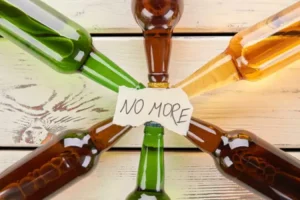
The binding of serotonin to its receptors initiates a series of biochemical events that converts the extracellular, chemical signal into an intracellular signal in the recipient cell. For example, the interaction of serotonin with one type of receptor stimulates the formation of small molecules (i.e., second messengers) within the cell. Second messengers interact with other proteins to activate various cellular functions, such as changes in the cell’s electrical activity or in the activity of certain genes (see figure). These changes can result either in the inhibition or the excitation of the signal-receiving neuron, depending on the cell affected. Through these mechanisms, serotonin can influence mood states; thinking patterns; and even behaviors, such as alcohol drinking.
Gut Microbiome and Autism Spectrum Disorder (ASD): Exploring the Connection and Potential Therapeutic Avenues
- Evidence suggests that the brain attempts to restore equilibrium after long-term alcohol ingestion (see figure).
- For example, in animals exposed for several days to alcohol, many neurotransmitter receptors appear resistant to the short-term actions of alcohol on glutamate and GABAA receptors compared with animals that have not been exposed to alcohol (Valenzuela and Harris 1997).
- Scientists have employed both bottom-up and top-down approaches, building from molecular targets to behavioral analyses and vice versa, respectively.
Some addictive substances affect dopamine directly, whereas alcohol and other drugs have an indirect effect. Alcohol is a small molecule, so it interacts with many neurotransmitters in the brain. Large molecules, like opiates or amphetamines, only stimulate a specific neurotransmitter. Addictive substances hook people physically by messing with their brain’s chemistry.
Alcohol and your mood: the highs and lows of drinking

In a conditioned place preference study, alcohol is reported to be dopamine-dependent in alcohol-naive animals but not in withdrawn, experienced, animals [132]. One possibility is that a dopamine-independent https://ecosoberhouse.com/ pathway is also involved in ethanol reinforcement [132, 133]. Executive functioning is a neurological process that guides our behavior by enabling us to pay attention to what is most important at the time.

Serotonin Levels in Alcoholics
A second feeding session that took place within 1 day of the first feeding session, however, induced no or only weak dopaminergic signal transmission. Only about 5 days after the first feeding session did the animals recover the full dopaminergic response to this stimulus. As discussed later in this article, however, alcohol does not induce a comparable habituation. As previously noted, long-term alcohol use may lead to a decrease in GABAA receptor function. In the absence of alcohol, the reduced activity of inhibitory GABA neurotransmission might contribute to the anxiety and seizures of withdrawal. These symptoms are treated, at least in part, using medications that increase GABAA receptor function, such as diazepam (Valium) and other sedatives.
- Together with OSU6162’s favourable side effect profile [198, 197, 199], these results render support for a larger placebo‐controlled efficacy trial in alcohol‐dependent patients to evaluate OSU6162’s effect on drinking outcomes.
- Nonetheless, our observed adaptations in dopamine uptake may contribute to the apparent changes in dopamine release following long-term alcohol consumption.
- Scientists postulate that this syndrome represents the hyperactivity of neural adaptive mechanisms no longer balanced by the inhibitory effects of alcohol (see figure).
- The motivation of behavior based on avoidance of discomfort is called negative reinforcement.
- In animal experiments, however, chronic exposure periods can last several months, and humans often will drink continuously for months or years at a time.
These substances usually trigger the release of dopamine, the body’s “feel-good” neurotransmitter. Once a person does something that trips the brain’s reward center, they feel good and are more likely to repeat the activity. A team of researchers from University of Oxford looked at data from 424 men and 103 women who are participating in the 10,000-person Whitehall Study, an ongoing investigation of the relationship of lifestyle and health among British civil servants. At the beginning of the study in 1985, all of the participants were healthy and none were dependent on alcohol. Over the next 30 years, the participants answered detailed questions about their alcohol intake and took tests to measure memory, reasoning, and verbal skills. A person with high levels of dopamine, whether due to temperament or to a transient—perhaps chemically induced state—can be described as a sensation seeker.
- Uncontrolled or abusive alcohol consumption is an undisputed global health concern with significant social costs and economic burdens.1 Individuals suffering from Alcohol Use Disorder (AUD) often display persistent patterns of alcohol use that escalates from abuse to dependence.
- This stimulation method is nonspecific and activates all axons and neurons near the stimulus electrode, including cholinergic interneurons.
- In contrast to the dorsal striatum, dopamine release in the NAc is increased following chronic alcohol use in male cynomolgous macaques [22, 24].
- A second feeding session that took place within 1 day of the first feeding session, however, induced no or only weak dopaminergic signal transmission.
- There is evidence of a link between serotonin deficiency, impulsivity and drinking behaviour which may explain the role of SSRIs in suppressing alcohol reinforced behaviour in some alcohol-dependent patients.
Free Healthbeat Signup
For instance, Kondo et al142 demonstrate the expression patterns of ionotropic glutamate receptors in the adult brain and larval muscle tissues. They further calculate that an average adult neuron expresses 30% of known neurotransmitter receptors. The T2A-GAL4 cassettes can also be replaced with other reporter cassettes for endogenous protein tagging and activity reporters. Thus, co-receptor expression patterns and endogenous labeling of receptors can be studied in the context of alcohol exposure. Detailed methods for these assays are available in Supplementary Materials and Methods. Collectively, these data indicate that dopamine plays a central role in reward, motivation and planning.


More research is needed to determine specific recommendations for increasing dopamine levels. Dopamine is produced from the amino acids tyrosine and phenylalanine, both of which can be obtained from protein-rich foods. Studies show that increasing tyrosine and another amino acid, phenylalanine, can raise dopamine levels in the brain, which may promote deep thinking and improve memory. On the other hand, eliminating phenylalanine and tyrosine can deplete dopamine levels (8, 10, 11). Potassium channels (KCNs) are found in most cell types and control a wide variety of cell functions. KCNs have a K+-selective pore and are sub-classified into 4 classes, either Ca2+-activated (KCNN), K+-activated (KCNA), inwardly rectifying (KCNJ), 2 pore domain channels (KCNK), or Na+-activated (KCNT) (Figure 1f; Table 1).

The dopamine deficiency hypothesis is supported by a study showing decreased dopamine receptor gene expression after several months of voluntary alcohol drinking [103]. In addition, microdialysis studies in freely moving outbred rats show a decreased dopamine output in the NAc, compared to age‐matched alcohol‐naïve controls, following 7 weeks [104] and 10 months [29] of voluntary alcohol consumption. Furthermore, after 10 months of drinking, a blunted dopamine response following a systemic alcohol challenge has been found in long‐term drinking, compared to alcohol‐naïve rats [29]. does alcohol increase dopamine These results indicate that long‐term drinking attenuates the responsiveness of the system to external dopamine stimulation, in addition to decreasing baseline levels of dopamine. The mesocorticolimbic dopamine system (or the so‐called brain reward system, Figure 1) is one of the established neurobiological systems involved during the development and maintenance of alcohol dependence and thus one potential treatment target. Here, we aim to review the animal and human data describing the role of dopamine and the mesolimbic dopamine system during acute and chronic alcohol exposure.
Further, it has been speculated that this dopamine deficiency is responsible for driving craving and compulsive drinking and contributes to relapse even after a period of protracted abstinence [18, 19]. The preclinical and clinical evidence of the underlying interaction between alcohol and the dopamine D2 receptors within the mesocorticolimbic dopamine system during the acute as well as during chronic intake is reviewed below. The involvement of the dopamine D1, D3, D4 and D5 receptors falls outside the scope of the present review but has previously been reviewed elsewhere [20].














